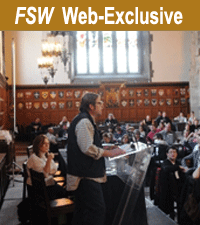Do you recall the last time you were truly inspired? Sure, the just completed Vancouver Olympics inspired an entire nation to come together and lose its collective mind over obscure winter sports such as ski jumping, speed skating and skeleton, but now that the Games are over, it will be four long years before Canadians do so again.
True inspiration has staying power. Its impact resonates. It’s felt on a deeper level, prompting you to take an introspective look at your present life and your future goals, and make the changes to help you achieve them.
Thankfully, for the hundred or so inspiration-seekers who gathered yesterday at Hart House on the campus of the University of Toronto, they didn’t have to look far. Innovative and inspirational figures were out en masse for the Terroir Hospitality Symposium (now in its fourth year). Arlene Stein, chair of the Terroir Steering Committee, spearheaded a team that assembled some of Ontario’s brightest foodservice stars, who happily interacted and shared their wisdom and experiences with their industry colleagues.
Symposium Chair Donna Dooher welcomed the guests, stating, “The hospitality industry shouldn’t take a back seat to the economy. We’re the gatekeepers of the nation, and we must embrace that role.” A presentation by Toronto-based and internationally acclaimed design mavens, Dan Menchions and Keith Rushbrook of II by IV Design, was followed by a lively discussion featuring award-wining food journalists from Canada and the U.S. Focusing on the role of media in the kitchen, the panel offered opinions on how chefs and restaurateurs should court the press, how Toronto can increase its exposure on the world’s culinary stage — without having to host a billion-dollar Olympic Games — and what exactly makes a city or region a great culinary destination.
“Paris is dead,” declared Alan Richman, a food writer for GQ magazine, noting that he prefers the intimacy and simplicity of dining in villages instead of large cities. Nevertheless, New York, Tokyo, Barcelona and, yes, Toronto, were lauded by the panel for their vibrant food cultures, but it was Mitchell Davis, vice-president of the James Beard Foundation in New York, who captured best what it takes to be a great food town. “Any place can be a great food city,” he said, after giving an unexpected nod to the humble and virtually undiscovered culinary scene in Milwaukee — a blue-collar city previously known for bratwurst and beer. “All it takes for a city to become a sought-out dining destination is a passionate citizenry that cares about food.”
The panel also debated the best way for chefs and restaurateurs to engage the media (both print and online) to ensure they get the coverage they desire. They urged restaurateurs to be positive and find “exciting narratives” to build around their businesses, because editors and food writers are always looking for great stories. They also offered some cautionary advice: “Never engage negative reviewers on the Internet,” said Gabriella Gershenson, editor of Time Out New York. “That’s one battle you won’t win.”
The day-long event featured morning and afternoon breakout sessions with topics like the impact oak barrels have on wine production; how to create a local food menu; the keys to successful restaurants; the power of mentorship; crafting cool and creative, bitter cocktails; and a lively, traditional debate about the time-honoured convention of tipping. Interestingly, before the debate on tipping began, 58 per cent of attendees at the session believed the current system works fine, while some 40 per cent were interested in experimenting with a new model. After the debate ended, it seems nobody was convinced otherwise — an exit poll showed the same figures.
The keynote address by David Kinch, chef/proprietor of Manresa, a two-Michelin-starred restaurant in Los Gatos, Calif., was the highlight of the day. Kinch grows all his own vegetables on a biodynamic farm he co-owns, creating a closed-loop system that was the envy of every chef in the house. Why? Because of taste. While food is highly politicized in California, Kinch is more interested in providing a highly hedonistic dining experience.
To build terroir — or “a sense of place” — into a restaurant, Kinch believes chefs must use quality products that are representative of the region. “You must show respect for those ingredients,” he said. “You must also learn about and pay heed to culinary tradition. Most importantly, you must have clientele in the region that is willing and able to support your restaurant, and you must exhibit maturity in everything you do. Ingredients are important, but it’s not just about products.”
True inspiration also leads to innovation. “Imitate, assimilate and then innovate,” he said, noting it’s crucial for chefs to not forget who they’re cooking for, no matter how creative or innovative they get. “Don’t cook for yourself or other chefs. Keeping you customers happy is the key.”
Of his farm, Kinch said that what he pulls from the earth, or what he’s planning on growing three seasons down the road, drives the dishes on his menu. “We formulate ideas, and then they germinate as the vegetables do.” Other salient points he made included his belief that the democratization of fine dining is vastly overrated — “This is where new ideas and trends come from” — the Far East will continue to have a positive impact on the fine-dining industry, because the great cuisines of Asia are all base on a sense of place, and that sincerity and integrity are the keys to terroir and to running a successful restaurant.
His speech was so warmly received he left the dais to a standing ovation.
Food for Thought
Of course, what would an industry-leading hospitality symposium be without great food? Terroir IV kicked off with a breakfast spread that would make any five-star hotel guest envious, followed by a relaxed and convivial sit-down lunch, and capped by a lively reception sponsored by Savour Stratford.
Like the GM of a championship team, Jonathan Gushue, Langdon Hall’s talented head chef, assembled an innovative, diverse F&B lineup of Savour Ontario Dining Chefs to prepare the food for the day. Showcasing top-quality, Ontario-grown ingredients, the lavish meals ensured each attendee enjoyed the day with a full belly.
Gushue’s roster was a veritable all-star team of top toques, including Toronto chefs: Michael Wilson (Crush Wine Bar); Fabio Bondi (Local Kitchen); Marco Tucci (Hart House); Tawfik Shehata (Vertical); and Nick Lui (Niagara Street Café). The out-of-town contingent are also among the province’s best, including: Michael Potters (Harvest in Picton), Jeff Crump and Scott Bailey (the Ancaster Old Mill); John Taylor (Domus in Ottawa), Jason Shubert and Paul Harding (The Only on King in London); Michael Sterpin (Elmhirst Resort in Peterborough); Traci Winkworth (The Belworth House in Waterford); and Frank Dodd (Hillebrand Estates Winery in Niagara).
And, notably, a sustainable dessert buffet showcased tasty treats made in a sustainable manner, truly showing everyone what innovation in the kitchen can accomplish. Coordinated by Chrystal Porter of Chocosol, the pastry team used renewable energy to create each decadent dish. Pastry chefs included, Rachelle Vivian of The Wine Bar, Bertrand Alepee of Amuse Bouche, Bettina Schormann of the Ancaster Old Mill and Sarah Villamere of Palais Royale.
Wines were provided by Henry of Pelham, Charles Baker and Tawse. Beau’s beer flowed in the afternoon and evening and an espresso bar by Paterna Coffee kept everyone perky.
TORONTO — Do you recall the last time you were truly inspired? Sure, the just completed Vancouver Olympics inspired a nation to come together and lose its collective mind over obscure winter sports such as ski jumping, speed skating and skeleton, but now that the Games are over, it will be four long years before Canadians do so again.
True inspiration has staying power. Its impact resonates. It’s felt on a deeper level, prompting you to take an introspective look at your present life and your future goals and make the changes to help you achieve them.
Thankfully, for the hundred or so inspiration-seekers who gathered yesterday at Hart House on the campus of the University of Toronto, they didn’t have to look far. Innovative and inspirational figures were out en masse for the
Terroir Hospitality Symposium (now in its fourth year). Arlene Stein, chair of the Terroir Steering Committee, spearheaded a team that assembled some of Ontario’s brightest foodservice stars, who happily interacted and shared their wisdom and experiences with their industry colleagues.
Symposium chair Donna Dooher welcomed the guests, stating, “The hospitality industry shouldn’t take a backseat to the economy. We’re the gatekeepers of the nation, and we must embrace that role.” A presentation by Toronto-based and internationally acclaimed design mavens Dan Menchions and Keith Rushbrook of II by IV Design, was followed by a lively discussion featuring award-wining food journalists from Canada and the U.S. Focusing on the role of media in the kitchen, the panel offered opinions on how chefs and restaurateurs should court the press, how Toronto can increase its exposure on the world’s culinary stage — without having to foot the bill for ludicrously expensive Olympic Games — and what exactly makes a city or region a great culinary destination.
“Paris is dead,” declared Alan Richman, a food writer for
GQ magazine, noting that he prefers the intimacy and simplicity of dining in villages instead of large cities. Nevertheless, New York, Tokyo, Barcelona and, yes, Toronto, were lauded by the panel for their vibrant food cultures, but it was Mitchell Davis, vice-president of the James Beard Foundation in New York, who captured best what it takes to be a great food town. “Any place can be a great food city,” he said, after giving an unexpected nod to the humble and virtually undiscovered culinary scene in Milwaukee — a blue-collar city best known for bratwurst and beer. “All it takes for a city to become a sought-out dining destination is a passionate citizenry that cares about food.”
The panel also debated the best way for chefs and restaurateurs to engage the media (both print and online) for coverage. They urged restaurateurs to be positive and find “exciting narratives” to build around their businesses, since editors and food writers are always looking for great stories. They also offered some cautionary advice: “Never engage negative reviewers on the Internet,” said Gabriella Gershenson, editor of Time Out New York. “That’s one battle you won’t win.”
The day-long event featured morning and afternoon breakout sessions with topics like the impact oak barrels have on wine production; how to create a local food menu; the keys to successful restaurants; the power of mentorship; crafting cool and creative, bitter cocktails; and a lively, debate about the time-honoured convention of tipping. Interestingly, before the debate on tipping began, 58 per cent of attendees at the session believed in the current system, while some 40 per cent were interested in experimenting with a new model. After the debate ended, it seems nobody was convinced otherwise — an exit poll showed the same figures.
The keynote address by David Kinch, chef/proprietor of Manresa, a two-Michelin-starred restaurant in Los Gatos, Calif., was the inspirational high point of the day. Kinch toils alongside grower Cynthia Sandberg on the biodynamic Love Apple Farm, which Sandberg owns, growing all his own vegetables and creating a closed-loop system that was the envy of every chef in the house. Why? Because of taste. While food is highly politicized in California, Kinch is more interested in providing a highly hedonistic dining experience.
To build terroir — or “a sense of place” — into a restaurant, Kinch believes chefs must use quality products that are representative of the region. “You must show respect for those ingredients,” he said. “You must also learn about and pay heed to culinary tradition. Most importantly, you must have clientele in the region that is willing and able to support your restaurant, and you must exhibit maturity in everything you do. Ingredients are important, but it’s not just about products.”
True inspiration also leads to innovation. “Imitate, assimilate and then innovate,” he said, noting how crucial it is for chefs to remember the diner. “Don’t cook for yourself or other chefs. Keeping your customers happy is the key.”
On his farm, Kinch’s harvest drives his menu. “We formulate ideas, and then they germinate as the vegetables do.” Other salient points he made included his belief that the democratization of fine dining is vastly overrated — “This is where new ideas and trends come from.” The Far East will continue to have a positive impact on the fine-dining industry, he said, because the great cuisines of Asia are all based on a sense of place, and that sincerity and integrity are the keys to terroir and to running a successful restaurant. His speech was so warmly received he left the dais to a standing ovation.
Food for Thought
Of course, what would an industry-leading hospitality symposium be without great food? Terroir IV kicked off with a breakfast spread that would make any five-star hotel guest envious. It was followed by a relaxed and convivial sit-down lunch and capped by a lively reception.
Like the GM of a championship team, Jonathan Gushue, Langdon Hall’s talented head chef, assembled an innovative, diverse F&B lineup of Savour Ontario Dining Chefs to prepare the day’s food. Showcasing top-quality, Ontario-grown ingredients, the lavish meals they created ensured each attendee was inspired with a full belly.
Gushue’s roster was a veritable all-star team of top toques, including Toronto chefs: Michael Wilson (Crush Wine Bar); Fabio Bondi (Local Kitchen); Marco Tucci (Hart House); Tawfik Shehata (Vertical); and Nick Lui (Niagara Street Café). The out-of-town contingent was also among the province’s best. It included: Michael Potters (Harvest in Picton), Jeff Crump and Scott Bailey (the Ancaster Old Mill); John Taylor (Domus in Ottawa), Jason Shubert and Paul Harding (The Only on King in London); Michael Sterpin (Elmhirst Resort in Peterborough); Traci Winkworth (The Belworth House in Waterford); and Frank Dodd (Hillebrand Estates Winery in Niagara).
And, notably, a dessert buffet showcased tasty treats made in a sustainable manner, truly showing innovation in the kitchen. Coordinated by Chrystal Porter of Chocosol, the pastry team used renewable energy to create each decadent dish. Pastry chefs included, Rachelle Vivian of The Wine Bar, Bertrand Alepee of Amuse Bouche, Bettina Schormann of the Ancaster Old Mill and Sarah Villamere of Palais Royale.
Photo by Jo Dickins





















